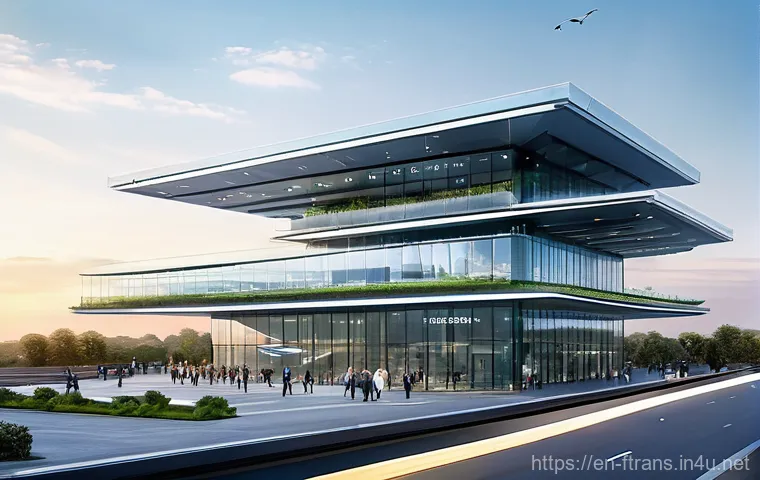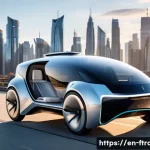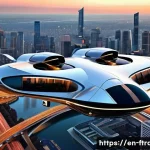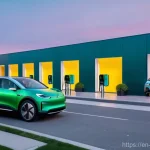Remember those futuristic movies where cars zipped effortlessly through the sky? Well, what once felt like pure science fiction is rapidly becoming a tangible reality, right before our eyes!
From pioneering eVTOLs (electric Vertical Take-off and Landing aircraft) undergoing rigorous test flights in places like Dubai and Los Angeles, to major companies making bold predictions for commercial air taxi services by 2025, the dream of flying cars is truly closer than ever.
It’s not just about bypassing frustrating traffic jams; it’s about reimagining how we live, work, and connect in entirely new ways. Of course, there are exciting challenges ahead, from perfecting safety systems to building the right infrastructure, but the sheer momentum is undeniable.
Let’s really explore how this incredible leap in technology is set to transform our world!
The Sky’s the Limit: Unpacking the Future of Personal Air Travel

From Science Fiction to Your City Streets (or Skies!)
I’ve been following the concept of flying cars for what feels like my entire life, always picturing those iconic scenes from movies where cars just lift off and vanish into the urban sprawl.
But honestly, for the longest time, it felt like a distant fantasy, something perpetually “around the corner” but never quite here. Now, though, I’m genuinely thrilled because what I’m seeing and hearing from innovators and regulators alike tells me we’re not just at a corner anymore; we’re on the runway, ready for takeoff!
It’s not just about one breakthrough; it’s a convergence of electric propulsion, advanced battery tech, and sophisticated AI that’s making this possible.
Think about it: a few years ago, the idea of an electric car being a mainstream option seemed a bit niche, and now they’re everywhere. I believe the same trajectory is on the horizon for urban air mobility.
This isn’t just about a rich person’s toy; it’s about fundamentally rethinking how we move, how we connect, and how we experience our cities. The sheer efficiency and potential to reclaim hours from soul-crushing commutes are incredibly exciting to me.
My Take: A Quieter, Cleaner Urban Landscape?
One of the most intriguing aspects, from my personal perspective, isn’t just the speed, but the potential for a significantly quieter and cleaner mode of transport, especially in urban areas.
I mean, imagine a world where the skies are filled with whisper-quiet electric aircraft instead of the constant rumble of combustion engines from above.
That sounds like a breath of fresh air, literally and figuratively! The vision of eVTOLs – electric Vertical Take-Off and Landing aircraft – buzzing silently around our skylines offers a stark contrast to the noisy helicopters we sometimes hear today.
It suggests a future where our urban soundscape might actually improve, leading to less noise pollution and a more serene environment. Plus, the commitment to electric power means a dramatic reduction in carbon emissions for personal and short-distance travel, which, let’s be honest, is a huge win for everyone concerned about the planet.
I truly believe that the environmental benefits alone are a massive driving force behind this revolution, offering a sustainable path forward for transportation in our increasingly crowded world.
Propelling Us Upwards: The Engineering Marvels Beneath Our Feet (and Wings!)
The Silent Revolution: Electric Propulsion and Battery Power
When I first started delving into the mechanics of these incredible machines, I was genuinely surprised by the sheer ingenuity. We’re not talking about tiny jets here, but sophisticated electric propulsion systems that are far more complex and efficient than you might initially imagine.
These aren’t just scaled-up drones; they are highly engineered aircraft designed for safety, redundancy, and efficiency. The biggest game-changer, in my opinion, has been the rapid advancements in battery technology.
Without powerful, lightweight, and energy-dense batteries, none of this would be possible. I’ve seen some prototypes that look like they belong in a futuristic art gallery, with multiple rotors designed not just for lift but also for stability and precise maneuverability, making the entire flight experience smoother.
The clever part is how many of these systems incorporate distributed electric propulsion, meaning they have multiple smaller motors spread across the airframe.
This not only offers incredible control but also adds a crucial layer of safety through redundancy – if one motor fails, the others can compensate.
Smarter Skies: AI and Autonomous Flight
Beyond the raw power, what truly blows my mind is the integration of artificial intelligence and autonomous flight capabilities. While human pilots will undoubtedly play a crucial role, especially in the initial phases, the long-term vision clearly involves highly automated, if not fully autonomous, systems.
I’ve read about companies developing advanced flight control software that can navigate complex urban environments, avoid obstacles, and even adjust to changing weather conditions in real-time.
This isn’t just about getting from point A to point B; it’s about optimizing routes for efficiency, minimizing energy consumption, and ensuring the safest possible journey for passengers.
From my conversations with people working in this field, the level of data processing and algorithmic sophistication required is immense, constantly learning and adapting.
It feels like we’re on the cusp of truly intelligent flight, where the aircraft itself can make instantaneous, informed decisions, far beyond human reaction times, making air travel safer than ever before.
It’s a testament to how far AI has come, moving from theory to practical application in an incredibly tangible way.
Charting the Airspace: Crafting the Rules for Our New Skies
Defining the Lanes: Regulatory Frameworks in the Making
This is where things get really fascinating and, admittedly, a bit complex. It’s one thing to build an amazing piece of technology, but it’s another entirely to integrate it safely and efficiently into an already crowded airspace.
From what I understand, regulatory bodies like the FAA in the United States and EASA in Europe are working tirelessly to develop entirely new frameworks for what’s being called “Urban Air Mobility” (UAM).
It’s not as simple as just saying “go for it.” They need to establish strict certification standards for the aircraft themselves, pilot training requirements (even for future autonomous systems that will still need human oversight), and, crucially, air traffic management systems that can handle a whole new dimension of aerial vehicles.
I’ve seen discussions about creating specific “air lanes” or corridors at different altitudes over cities, much like highways, to prevent collisions and manage flow.
It’s an intricate dance between innovation and safety, ensuring that as these vehicles become more common, they don’t pose new risks to people on the ground or in the air.
This collaborative effort across engineering, government, and urban planning is critical for the success of this entire endeavor.
Safety Above All: Building Trust in a New Era of Flight
When I talk to people about flying cars, the first question, almost without fail, is about safety. And rightly so! No one wants to step into a new vehicle that they don’t implicitly trust.
This is precisely why the regulatory process is so rigorous and why manufacturers are pouring immense resources into redundant systems, fail-safes, and exhaustive testing.
Think about how commercial airliners operate; they have multiple layers of backup for every critical system. eVTOLs are being designed with a similar philosophy.
We’re talking about multiple motors, independent power sources, sophisticated flight control software that constantly monitors performance, and even ballistic parachutes in some designs.
I’ve seen videos of these aircraft undergoing incredibly demanding test flights, pushing them to their limits to identify any potential vulnerabilities.
From my perspective, ensuring public confidence is paramount. It’s not just about meeting a checklist; it’s about demonstrating, repeatedly and transparently, that these aircraft are as safe, if not safer, than existing modes of transport.
The industry understands this, and it’s why safety isn’t just a feature – it’s the bedrock of this entire revolution.
Groundwork to Airspace: Building the Vertiports of Tomorrow
Beyond the Runway: The Rise of Vertiports and Charging Hubs
Here’s something I hadn’t fully considered until I really started looking into it: where will these flying machines actually land and take off? We’re not talking about traditional airports; we’re talking about “vertiports.” These aren’t just glorified helipads; they’re envisioned as multi-modal hubs integrated into the urban fabric – perhaps on top of skyscrapers, at existing transport hubs, or even purpose-built structures in city centers.
I’ve seen some incredible architectural concepts that look straight out of a sci-fi movie, designed not only for the safe landing and takeoff of eVTOLs but also for efficient passenger flow, security checks, and, crucially, rapid charging of the electric batteries.
The challenge is immense, as it involves significant urban planning, zoning changes, and substantial investment. It’s not just about a platform; it’s about the infrastructure to support dozens, if not hundreds, of flights per day in a single location.
From what I’ve gathered, these vertiports will be critical nodes in the urban air mobility network, acting as transfer points where you might hop out of an air taxi and seamlessly transition to a ground taxi, subway, or ride-share service.
Connecting the Dots: Seamless Integration with Ground Transport
What’s clear to me is that the success of urban air mobility isn’t just about getting airborne; it’s about making the entire journey seamless. Imagine booking an air taxi through an app, just like you would a car.
The app would factor in your entire journey, from your doorstep to your final destination, recommending the fastest and most efficient combination of ground and air travel.
I envision a future where these vertiports are meticulously integrated with existing public transportation networks, ensuring that a quick flight doesn’t just drop you off in an isolated spot.
This holistic approach is key to mass adoption. It means smart routing, predictive analytics for demand, and coordination between various transport providers.
From my own experiences with travel, the “last mile” or “first mile” connection is often the most frustrating part. By truly integrating air taxis into the broader transportation ecosystem, we can eliminate those friction points and make air travel a genuinely convenient option for daily commutes, not just a novelty.
It’s about designing a user experience that prioritizes efficiency and ease, making the switch between modes of transport almost imperceptible.
The Race to the Skies: Who’s Leading the Charge?

Pioneering Flights: The Key Innovators and Their Visions
It’s truly exhilarating to see the sheer number of companies throwing their hats into the ring, each with a slightly different vision for how urban air mobility will unfold.
From established aviation giants to nimble startups, the innovation coming out of this sector is truly impressive. I’ve been keeping a close eye on a few key players that seem to be making significant strides, not just in terms of prototypes but also in securing funding, regulatory approvals, and building partnerships.
Companies like Joby Aviation, Archer Aviation, and Lilium are constantly in the news, showcasing their aircraft and outlining ambitious plans for commercial operations in the very near future.
What’s striking is the diversity in design – some are multicopters, others are more wing-based, reflecting different approaches to efficiency and range.
Each company is trying to carve out its niche, whether it’s focusing on inter-city travel, dense urban routes, or even specific use cases like cargo delivery.
It feels like we’re watching the birth of a new industry right before our eyes, and the competition is fierce, driving even faster innovation.
Beyond the Prototypes: What’s Next for the Industry?
While prototypes and test flights grab the headlines, what I find equally compelling are the strategies these companies are employing to scale up. It’s not enough to build one amazing aircraft; they need to think about manufacturing at scale, building out service networks, and forging crucial partnerships.
For instance, some are collaborating with airlines to integrate air taxi services into existing travel itineraries, while others are partnering with ride-sharing companies to leverage their vast user bases.
I even saw one company discussing potential collaborations with real estate developers to build vertiports directly into new urban developments. This foresight and strategic planning are what will truly determine who becomes a dominant player in this nascent market.
The investment required is astronomical, so strategic alliances are key. It’s clear that the path to commercialization isn’t just about the technology; it’s about building an entire ecosystem around it.
The table below gives a quick snapshot of some of the major players and their current focus.
| Company | Headquarters | Key Focus | Notable Progress |
|---|---|---|---|
| Joby Aviation | Santa Cruz, California, USA | Air taxi services, eVTOL development | FAA Part 135 air carrier certification; extensive test flights |
| Archer Aviation | San Jose, California, USA | Urban air mobility, eVTOL manufacturing | Partnerships with United Airlines; aiming for commercial service by 2025 |
| Lilium | Munich, Germany | Regional air mobility, longer-range eVTOLs | Developing a unique jet-powered eVTOL; focuses on inter-city travel |
| Wisk Aero | Mountain View, California, USA | Autonomous eVTOLs, air taxi services | Joint venture with Boeing; focuses on self-flying aircraft |
| Volocopter | Bruchsal, Germany | Urban air mobility, piloted and autonomous eVTOLs | Public demonstrations in several cities; aims for short-distance routes |
The Daily Grind Transformed: A Glimpse into the Future Commute
Reimagining Urban Living: From Congestion to Connectivity
Let’s be honest, the daily commute in many major cities can be a soul-destroying experience. Gridlock, crowded trains, and wasted hours are just part of the routine for millions.
This is where flying cars, or more accurately, air taxis, offer such a compelling vision. Imagine bypassing all that ground traffic, taking off from a vertiport near your home, and landing directly on a rooftop vertiport near your office building.
The time savings alone could be revolutionary, giving people back precious hours of their day – hours they could spend with family, pursuing hobbies, or simply relaxing.
From my perspective, this isn’t just about saving time; it’s about reducing stress and improving quality of life for urban dwellers. It fundamentally reshapes our relationship with distance and makes areas that were once considered too far for a daily commute suddenly viable.
It feels like unlocking a new dimension of urban planning, where connectivity isn’t just about roads and rail, but also about the direct routes through the sky.
My Vision: How Air Taxis Will Change Your Routine
I’ve been thinking a lot about how this could realistically integrate into my own life, or anyone’s life, for that matter. Picture this: you wake up, check your flight booking on your phone – perhaps it’s part of a subscription service, or a pay-per-use model.
You head to a nearby vertiport, maybe a brisk walk or a short e-scooter ride away. Security is quick, much like a subway, not an airport. You step into a sleek, comfortable cabin – perhaps with just a few other passengers, or even a private pod.
The takeoff is smooth and quiet, and suddenly you’re above the city, enjoying panoramic views while cruising effortlessly to your destination. Instead of hours stuck in traffic, your journey might take mere minutes.
Then, upon arrival, you seamlessly transition to another mode of transport for your final few blocks. This shift isn’t just about speed; it’s about reclaiming agency over your time and reshaping your daily routine in a way that truly prioritizes efficiency and comfort.
It’s a bold vision, but based on the progress I’m seeing, it’s one that I believe is increasingly within our grasp.
Wrapping Things Up
As we stand on the precipice of this incredible transformation, I can’t help but feel a profound sense of optimism. What once felt like pure fantasy is now rapidly approaching reality, fueled by relentless innovation and a shared vision for a more connected, efficient, and enjoyable urban life. It’s more than just a new mode of transport; it’s a reimagining of our cities, our commutes, and our very relationship with time. The journey ahead will undoubtedly have its challenges, but seeing the sheer dedication from engineers, regulators, and visionaries alike, I truly believe we’re well on our way to a future where the sky isn’t just a limit, but a new highway.
Useful Information to Keep in Mind
1. Stay Informed on Local Regulations: Keep an eye on your local aviation authorities (like the FAA in the U.S. or EASA in Europe) as they finalize regulations for Urban Air Mobility. These frameworks will dictate where and when air taxis can operate in your area, and understanding them will give you a real edge on when to expect services to roll out.
2. Understand the Different Aircraft Types: Not all “flying cars” are created equal! Familiarize yourself with eVTOLs (electric Vertical Take-Off and Landing aircraft), which are currently at the forefront of this revolution. Knowing the difference between a multi-rotor design and a lift-plus-cruise configuration can help you appreciate the specific advantages and use cases each company is targeting.
3. Consider the Infrastructure Impact: Vertiports are going to be a crucial part of this ecosystem. Think about how these landing and charging hubs will integrate into urban environments. Will they be on rooftops, at existing transport hubs, or purpose-built? Their location will significantly influence travel times and accessibility, much like how subway stations define a city’s public transport network.
4. Keep an Eye on Key Players and Partnerships: The landscape of urban air mobility is dynamic. Follow companies like Joby Aviation, Archer Aviation, Lilium, and Volocopter. Pay attention to their partnerships with airlines, ride-sharing companies, and even real estate developers, as these collaborations will be key indicators of their path to commercialization and wider adoption.
5. Think About Future Career Opportunities: As this industry grows, it will open up a plethora of new job opportunities. From eVTOL pilots and maintenance technicians to vertiport operators and specialized software engineers for air traffic management, consider how your skills might align with this emerging sector. It’s an exciting time for innovation, and the workforce will need to adapt accordingly.
Key Takeaways for a High-Flying Future
A Confluence of Innovation: Technology Paving the Way
What truly sets this current wave of personal air travel apart is the remarkable convergence of several cutting-edge technologies. We’re talking about vastly improved battery density that allows for practical electric propulsion, making these aircraft quieter and significantly more environmentally friendly than their predecessors. Then there’s the sophisticated AI and autonomous flight systems that promise to make air travel safer and more efficient, reducing human error and optimizing routes in real-time. From my vantage point, having followed technology trends for years, it feels like all the pieces of the puzzle are finally fitting together, creating a robust foundation for a truly transformative transportation network. It’s not just one breakthrough, but a symphony of technological advancements working in concert.
Navigating the Skies: The Crucial Role of Regulation and Infrastructure
While the tech is exhilarating, the practical implementation hinges heavily on well-defined regulatory frameworks and robust ground infrastructure. Agencies like the FAA and EASA are diligently crafting new rules for Urban Air Mobility, focusing on everything from aircraft certification and pilot training to creating entirely new air traffic management systems for urban skies. This painstaking process, though lengthy, is absolutely vital for ensuring public safety and building trust. Complementing this, the development of vertiports – integrated landing, charging, and passenger hubs – will be the physical anchors of this new network. These aren’t just minor additions; they require significant urban planning and investment to ensure seamless connectivity with existing ground transportation, truly making the “door-to-door” journey efficient and appealing. It’s a complex undertaking, but one that’s absolutely critical for success.
Beyond the Commute: A New Era of Urban Living and Economic Opportunity
Ultimately, the impact of personal air travel extends far beyond simply cutting down commute times. It has the potential to fundamentally reshape urban living, reducing congestion on our roads and opening up new possibilities for connectivity between previously isolated areas. Imagine the economic opportunities that will arise, from manufacturing and maintenance jobs to new service industries built around vertiport operations and air taxi logistics. From a personal quality-of-life perspective, reclaiming hours from daily commutes will be invaluable, allowing people more time for family, leisure, or personal development. This isn’t just about faster travel; it’s about fostering a more livable, sustainable, and connected future for our cities. The excitement in the industry is palpable, and I truly believe we’re on the cusp of an incredible new chapter in human mobility.
Frequently Asked Questions (FAQ) 📖
Q: So, when can we realistically expect to hop into one of these flying cars, or “air taxis”?
A: Honestly, it feels like we’re standing right on the cusp of a whole new era! From what I’ve personally been following, major players in the eVTOL space are pretty confident about launching commercial air taxi services by as early as 2025.
We’ve seen incredible progress with rigorous test flights happening in places like Dubai and Los Angeles – places that truly embrace future-forward tech.
Now, while 2025 sounds incredibly close (and it is!), it’s important to remember that widespread availability won’t happen overnight. We’ll likely see initial rollouts in select cities or for specific routes, perhaps connecting airports to city centers, or offering premium travel options.
Think of it less like suddenly everyone owns a flying car, and more like a gradual introduction of a new, incredibly efficient mode of public transit or specialized service.
But trust me, the momentum is absolutely undeniable, and I’m genuinely excited to see those first services take flight!
Q: Beyond just skipping traffic, how will flying cars truly reshape how we live, work, and connect?
A: Oh, this is where it gets really exciting! While beating those soul-crushing traffic jams is a huge draw, flying cars, or eVTOLs, are poised to do so much more than just cut down your commute.
Imagine connecting suburban areas with downtown business districts in minutes, opening up entirely new possibilities for where people can live and work without being tethered to ground transportation.
I’ve been thinking a lot about the potential for regional travel – a quick hop between cities that might currently take hours by car or train. It’s not just about personal convenience; consider the impact on emergency services, rapid delivery of vital goods, or even eco-tourism, allowing access to stunning natural landscapes with minimal environmental footprint.
This isn’t just a new vehicle; it’s a reimagining of our urban and regional landscapes, fundamentally changing how we access opportunities, experience our world, and build communities.
It’s truly about making our world feel a little bit smaller and a lot more accessible.
Q: What are the biggest hurdles and challenges that need to be cleared before flying cars become a common sight in our skies?
A: This is a fantastic question because it’s not just about the technology of the vehicle itself, but the entire ecosystem around it. From my perspective, one of the absolute biggest challenges is perfecting safety systems and, hand-in-hand with that, integrating these new aircraft into existing air traffic control.
We’re talking about a completely new dimension of airspace management! Then there’s the infrastructure – where will these eVTOLs take off and land? We need “vertiports” strategically placed, and that requires urban planning, noise considerations, and public acceptance.
And of course, regulation is key. Governments worldwide are scrambling to develop robust frameworks for certification, pilot licensing, and operational guidelines to ensure everyone’s safety and confidence.
It’s a monumental undertaking, but seeing the rigorous testing and collaboration between developers, regulators, and cities, I’m optimistic. It’s truly a testament to human ingenuity to tackle such complex, multifaceted challenges head-on.






